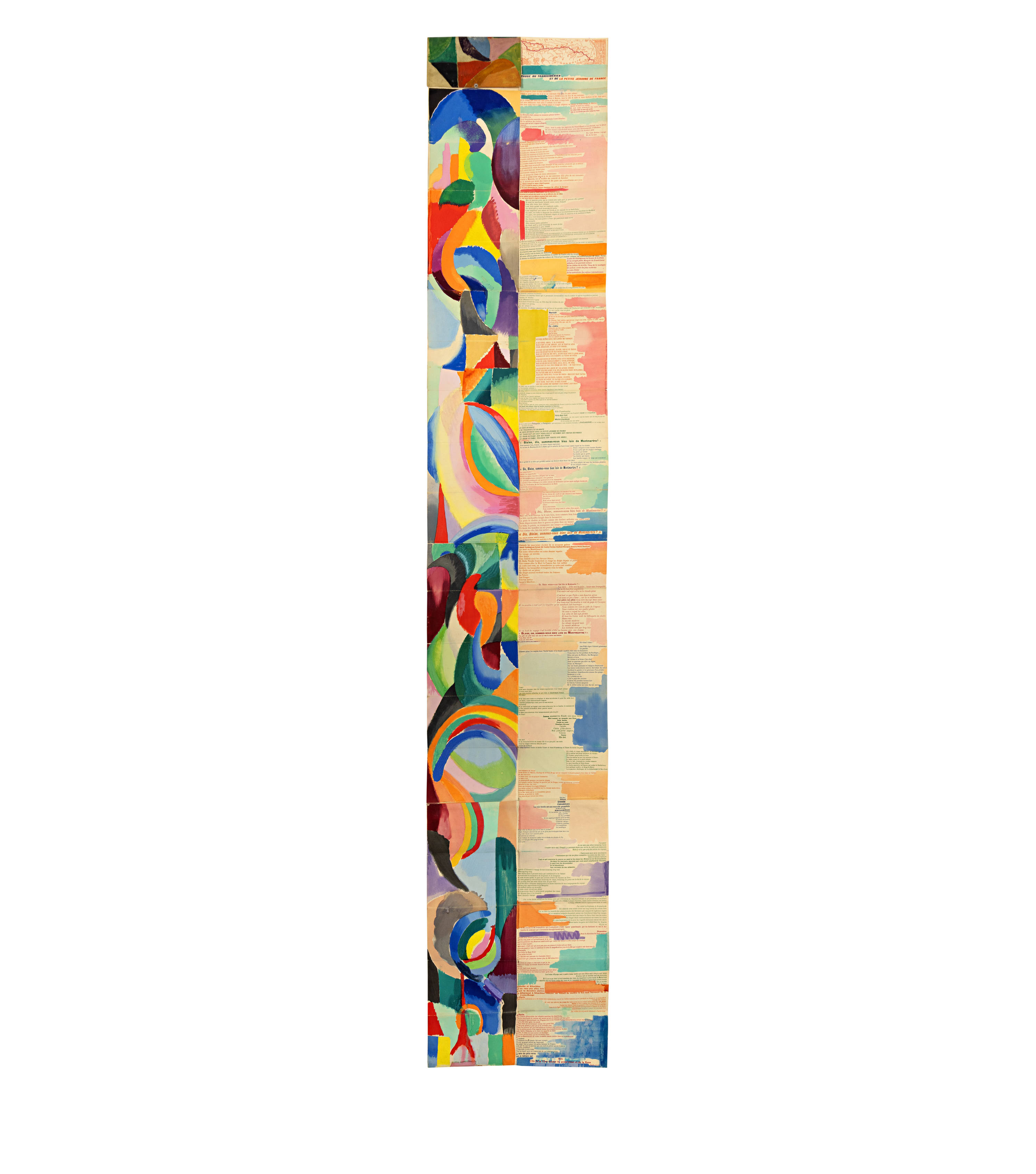- FR
S’inscrire
- Acheter
- Vendre
- Plus
- Galerie
- Commerce d'art
- Maison d'Édition
- Kornfeld aujourd’hui
- L'histoire de la Maison
- Informations















Gradischsk 1885 - 1979 Paris
Mise en vente le 13/09/2024,
vers 15:25 h (CET)
(+/- 30 min)
1913
Illustrated book, hand-coloured in pochoir technique
207.4x36.2 cm
Signed "Blaise Cendrars" by the autor at the top of the title and "Sonja Delaunay" by the artist. Numbered "42"
Marc Loliée, Libraire, Paris, purchased there in 1976 by
Private collection, Biel-Bienne, on commission to
Daniel Thierstein antiquarian bookshop, Bern/Biel, acquired there in 2007 from
Private collection Switzerland
In very good condition and extremely fresh in colour
When Sonia Delaunay-Terk met the previously unknown poet Blaise Cendrars, whose real name was Fréderic Louis Sauser, at Guillaume Apollinaire's in January 1913, she was one of the pioneers of abstraction with her "Contrastes simultanés" ("Simultaneous contrasts" ), together with her artist husband Robert. They became friends and began a joint work of art, the first "simultaneous" artist's book.
It is based on a 445-line poem by Cendrars about an imaginary journey with the young prostitute "Jehanne" on the Trans-Siberian Railway across Russia during the first revolution in 1905. A map of the journey can be seen at the top left. The journey leads from Moscow to Siberia, China, the North Pole and finally to Paris. The text is about a long, depressing journey with apocalyptic scenes of war and revolution as well as descriptions of cold, hunger, death and devastation.
The usual form of a bound book was abandoned in favour of a kind of long sheet; the hand-coloured illustrations, individually applied using the "pochoir method", run parallel to the text, interweaving with it in many places and thus creating a further level of interpretation. They are abstract, but evoke the text in an impressive way, especially the arrival in Paris, the lifesaving destination, towards the end of the poem, impressively introduced with a shadowy red Eiffel Tower. Each copy is coloured slightly differently, making it unique. The work is an early example of the deliberate use of multiple, different and colourful typographies (30 in total) in order to better express moods.
The text was printed on four sheets, which were then glued together with an overlap. With a total height of just over 200 cm, the planned total print run of 150 copies together would have been as high as the Eiffel Tower, the symbol of progress. When folded, the result was a format of circa 17.5 × 10.5 cm. In this case, the sheet was folded and incorporated into a specially designed and painted parchment cover.
The "book" was a sensation in Parisian avant-garde circles when it was published and is still considered one of the most important modernist artists' books ever.
Of the planned edition of 150, only 60 to 100 were produced in full, probably for cost reasons, and most copies are now in public collections.
1913
Illustrierter Buchdruck, handkoloriert im Pochoir-Verfahren
207,4x36,2 cm
Oben im Titel vom Schriftsteller signiert "Blaise Cendrars" und von der Künstlerin "Sonja Delaunay". Nummeriert "42"
Marc Loliée, Libraire, Paris, dort 1976 angekauft von
Privatsammlung, Biel-Bienne, in Kommission an
Buchantiquariat Daniel Thierstein, Bern/Biel, dort 2007 erworben von
Schweizer Privatsammlung
Äusserst farbfrisch und in sehr guter Erhaltung
Als Sonia Delaunay-Terk im Januar 1913 bei Guillaume Apollinaire den bisher unbekannten Poeten Blaise Cendrars, eigentlich Fréderic Louis Sauser, kennenlernte, gehörte sie mit ihren "Contrastes simultanés" zusammen mit ihrem Künstlergatten Robert zu den Wegbereitern der Abstraktion. Sie wurden Freunde und begannen ein gemeinsames Kunstwerk, das erste "simultane" Künstlerbuch.
Grundlage ist ein 445 Zeilen langes Gedicht von Cendrars über eine imaginäre Reise mit der jungen Prostituierten "Jehanne" in der Transsibirischen Eisenbahn quer durch Russland während der ersten Revolution 1905. Oben links ist eine Karte der Fahrt zu sehen. Die Reise führt von Moskau nach Sibirien, China, zum Nordpol und schliesslich nach Paris. Der Text handelt von einer langen, bedrückenden Fahrt mit apokalyptischen Szenen von Krieg und Revolution sowie Beschreibungen von Kälte, Hunger, Tod und Verwüstung.
Die gebräuchliche Form eines gebundenen Buches wurde zugunsten einer Art langem Bogen aufgegeben; die im "Pochoir-Verfahren" einzeln angebrachten, handkolorierten Illustrationen verlaufen parallel zum Text, verflechten sich vielerorts mit ihm und schaffen so eine weitere Interpretationsebene. Sie sind abstrakt, nehmen jedoch den Text eindrücklich auf – erwähnt sei gegen Ende des Gedichts die Ankunft im "rettenden" Paris, das mit einem schemenhaft angedeuteten roten Eiffelturm eindrücklich eingeführt wird. Jedes Exemplar ist leicht anders koloriert und wird so zu einem Unikat. Das Werk ist ein frühes Beispiel für den gezielten Einsatz von mehreren, unterschiedlichen und farbigen Typographien (30 an der Zahl), um damit Stimmungen besser ausdrücken zu können.
Der Text wurde auf vier Bogen gedruckt, die danach überlappend zusammengeklebt wurden. Bei einer Gesamthöhe von etwas über 200 cm wäre die geplante Gesamtauflage von 150 Exemplaren zusammen so hoch gewesen wie der Eiffelturm, das Symbol des Fortschritts. Gefaltet ergab sich ein Format von ca. 17,5 × 10,5 cm. Im vorliegenden Fall wurde das Blatt gefaltet und in einen eigens gestalteten und bemalten Pergamentumschlag eingearbeitet.
Das "Buch" war bei seinem Erscheinen eine Sensation in den Pariser Avantgardekreisen und gilt bis heute als eines der wichtigsten modernistischen Künstlerbücher überhaupt.
Von der geplanten Auflage von 150 wurden wohl aus Kostengründen nur 60 bis 100 komplett produziert, die meisten Exemplare befinden sich heute in öffentlichen Sammlungen.
| Suisse | CHF | Offre individuelle |
| Europe | CHF | Offre individuelle |
| Outre-mer | CHF | Offre individuelle |
















